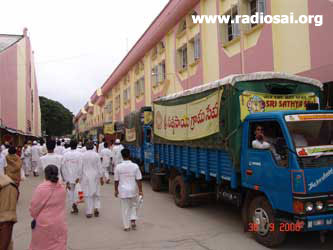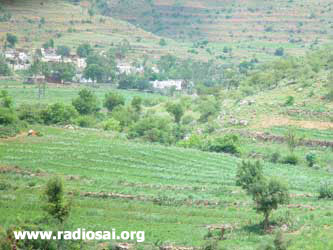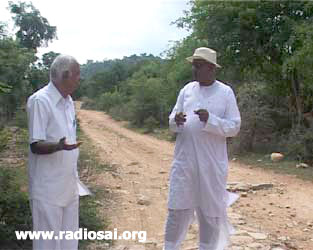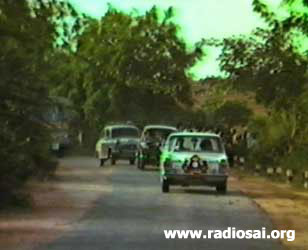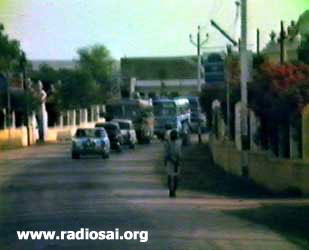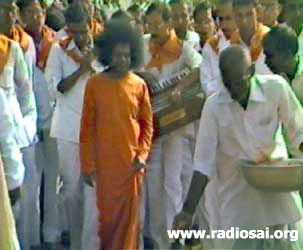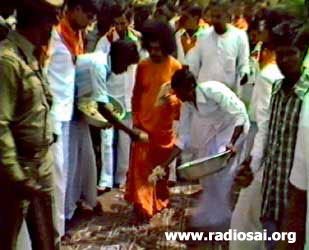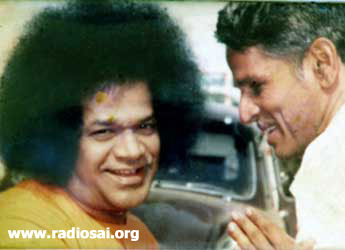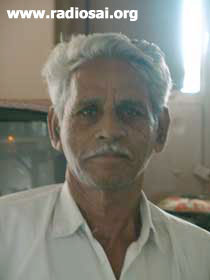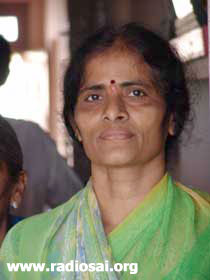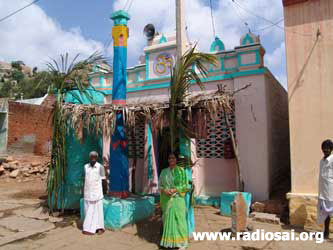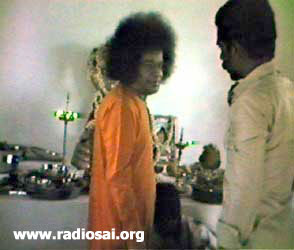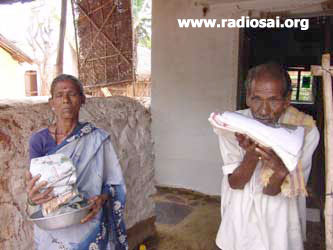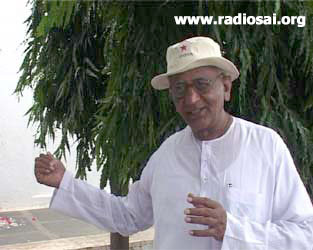| |
A PEEP INTO THE EYES OF GOD
By Prof. G. Venkataraman
I have had the privilege of being associated with Grama Seva from its inception in 2000, though the nature of the association has varied over the years. During the first few years, I was actively involved with the actual distribution in the villages. Later, I had to look after documentation via photography, videography, and on-site interviews. More recently, I have been asked, along with a few other elders, to go to the villages every day to oversee and make sure everything is going alright. This year too I had this responsibility, but on one day, September 30th to be precise, I took off from the assigned duty to go with Warden Sri Narasimha Murthy to two villages, Ragepalli and Ammagondapalem, visited personally by Swami in May 1985. Sri Narasimha Murthy accompanied Bhagavan during that historic visit, and I was keen to revisit those villages along with Sri Narasimha Murthy to try and relive some of those memorable moments. What follows is a brief account of my pilgrimage.
H2H: Off-road and into the Bush
I have been hearing about Ammagondapalem for many years and always wanted to go there. But somehow, something or the other intervened to put my intended visit off. Access to that village is not easy. The road, if one can call it that, is pretty bad, and believe it or not, the village is surrounded by forests. Moreover, the area is supposed to be infested with Naxalites or insurgents, and I was advised to avoid the place! So I told myself, “This year during Grama Seva, I shall go along with the others to this village – this way I would have a backup in case of breakdown, etc.” The schedule showed that Ammagondapalem was to be served on 30/09, so I took off from my normal duty and wore my Radio Sai/H2H hat. Thus it was, on the morning of Saturday 30th, I got into a Tata Sumo which followed behind the Qualis vehicle in which Sri Narasimha Murthy went around doing his supervisory duty. With me were a couple of our studio boys, handling the video camera, the still camera, and the sound recording.
A Convoy of Trucks, a Party of Hundreds, Swami’s Prasadam
We left the ashram at around 9:00 a.m. at the head of a big convoy of trucks carrying hundreds of students and teachers and, of course, Swami’s Prasadam in the form of clothes, food, and sweets. We crossed the Chitravati River on the new causeway that makes the river crossing so easy. Entering Karnatakanagepalli, once the gateway to Puttaparthi when the latter was a remote hamlet, we turned right and sped along. The road was very good and everything was green and beautiful.
A few kilometers along the road, Sri Narasimha Murthy’s van, which was ahead of us, stopped to check the convoy formation to see if anyone had any problems. Vehicle after vehicle went past, reporting by wireless. Occasionally, a truck would stop for instructions. After the last truck passed, Sri Murthy came to our vehicle – we were all out and the boys were shooting away.
The Warden told me, “Take a look at the lake there. There is not much water there now, but years ago it used to be full of water. It is called Sahib Cheruvu. In the early 60s Swami came here many times with a small group to have a picnic. I myself have had the pleasure of being in His company here a few times.” I asked, “You mean it was like the Chitravati outings we read about?” “Yes, something like that, except it would be during daytime whereas the Chitravati outings used to be in the evenings.”
|
|
|
The convoy of trucks waiting to start |
|
The Sahib Cheruvu Lake |
Crawling Along the (Rough) Road to Ammagondapalem
We then moved on and made a right turn into a dirt track. The road suddenly became rough and the terrain hilly. We were now crawling at around 5 km/hour, barely ten kilometers from Puttaparthi – that shows the huge gulf that separates villages from urban areas. I learned that our driver, a young man twenty plus, was actually from Ammagondapalem. He now lives in Puttaparthi with his parents, but he still has plenty of contacts with his native village. This was evident from the numerous people who greeted him as we slowly made our way up. At times, he slowed down to briefly exchange some small talk.
Embedded here and there in the low regions of the hilly terrain were fields. In some places, the going was steep and the road really bad. Our driver told me that there was a bus service to the villages we were going to: one bus a day! The bus would go in the evening, halt there for the night, and leave in the morning. Seeing the road, I am surprised how the bus managed to travel; it sure must be taking a huge beating, no question about that. In many places, the road crossed a stream, now dry. The dry bed was littered with rocks and stones of various sizes, no doubt pushed there by the current when the streams became flooded in the rainy season. The stream crossings, except in one place, had no pathway, and the going was really tough. Here and there, to help the bus move, the road had been crudely paved with big stones. Truly speaking, only a tough army jeep can negotiate this so-called road. All along, I kept wondering: “If this is how bad the road is in 2006, how much worse must it have been in 1985! How on earth did Swami make it here?” I got the answer a little later, as I shall describe.
|
|
|
The dirt track road |
|
The hilly terrain |
Meanwhile, we crawled and slowly the scene changed. The farmland was behind us and we were now in a forest, yes a real forest, not with huge trees but a lot of thick bush; and in many places it was quite hilly. In between, we had a panoramic view and our driver told us that up on one of the hills there is an old bungalow going back to British times. He added that in those days, the [British] Forest Officer used to stay in the bungalow during his inspection trips. Even today, the forests are there but not the animals, that is for sure. However, seventy or eighty years ago there must have been wild animals, at least cheetahs and leopards, and possibly the occasional tiger. In fact, Mr. Giri, who succeeded me as the Vice Chancellor, told me that about a hundred fifty years ago, Puttaparthi was right in the middle of an elephant migration track from Bellary to Kuppam – a couple of hundred kilometers long, I think. I have also seen writings by old timers reporting that in those days when they went to the Chitravati River for a bath, they would occasionally see cheetahs drinking water!
|
|
1985 – the Road was Better!
After nearly an hour of patient slogging, we stopped because the van ahead of us had. I did not know what the problem was, but seeing Narasimha Murthy get out, I did as well to stretch my limbs. A small conversation ensued, which went as follows:
I ask, “How far are we from our destination?”
“We are now about a kilometer away from the Ragepalli.”
“And how far is Ammagondapalem from Ragepalli?”
|
A quick chat by the road |
|
|
“Oh, I would say less than two kilometers.”
“You came with Swami in 1985. The road must been much worse then.”
“Actually, it was better. In fact, Swami came in His white Benz car.”
“Benz car? Here? You must be kidding.”
“No, sir, He actually did come by the Benz car. But you see, prior to His visit, Swami’s students worked here for days to cover the road with mud to make it suitable for a car to travel.”
“Oh, I see.”
“But one thing. We did not cross the Chitravati River like we did this morning. We took a roundabout route.” |
|
|
| |
Swami`s white Benz on its way to the village |
“You mean you went first to Kothacheruvu, then to Bukkapatnam and all that?”
“Correct. This causeway saved us something like twenty kilometers. I must also tell you something else.”
“What is that?”
Divine Compassion for an Intrepid Photographer
|
|
“We made a few stops on the way. And in all those places, there was a man with a camera, who was taking pictures of Swami’s historic visit. This man was not a member of our party, but so great was his love for Swami and so keen his interest in recording this visit that he actually walked and ran with our vehicles all the way. In one place, Swami told us, ‘See that man? Take him in your jeep. He is walking all the way, poor fellow.’ That is how compassionate Swami is. So we took that photographer on board, and later he became Swami’s official photographer for some years.”
Soon we resumed the journey and entered Ragepalli, which in earlier days used to be known as Kammavaripalli. Our vehicles stopped at the edge of the village. From there we walked, with Narasimha Murthy giving me a step-by-step recall of the path traversed by Swami in 1985 and what exactly happened then. After about a hundred meters, we came to a small temple. This was where most of the action took place, and once again, Narasimha Murthy told me all about what happened. The detailed account of all that is in the box below by Sri Sanjay Sahani, currently Principal, Brindavan Campus, then a Post Graduate student. This article appeared in Sanathana Sarathi in June 1985. |
Sri Sanjay Sahani |
|
A JOURNEY WITH BHAGAWAN
May 26, 1985: The day dawned, heralding a new phase in the history of the Sri Sathya Sai Institute of Higher Learning and in our national life. |
Having willed that the International Year of Youth shall be marked by the involvement of His students in His village adoption program, Swami took us, boys and girls, and the teachers of the three campuses at Prashanti Nilayam, Brindavan, and Anantapur, to the villages of Kammavaripalli and Ammagondapalem in the Sri Sathya Sai Taluk.
Earlier, under Swami’s guidance, service activities in the villages had commenced on May 16. Repairing roads, making soak pits, etc., were some of the activities taken up by the boys, while health and hygiene in the villages was the concern of the girl students.
It was a big convoy – twelve vehicles in all – that left Prashanti Nilayam early that morning. It passed through a number of villages, with the students singing bhajans on the way. It was thrilling to watch the reverence with which the villagers greeted Swami as His car passed by. At one place there was a virtual roadblock by the villagers wishing to pay their homage to Swami. It was tactfully cleared by the students in the escort party. |
|
|
| |
Big Convoy |
Kammavaripalli Welcomes Baba
After almost a two-hour drive through hilly country, the convoy stopped on the outskirts of Kammavaripalli. Swami was welcomed by the village elders and He entered the village with the students doing Nagarasankirtan. The procession halted at the pandal set up in front of the village temple. |
|
|
|
The Procession |
|
Swami Installing The Idols
|
In the inner sanctum, Swami installed idols of Rama, Lakshmana, Sita, and Anjaneya and presented a set of musical instruments to the village Bhajan Mandali. Swami then asked the Institute boys to give a recital of the Rama Katha with its lilting folk tunes. This was followed by a short speech by Sri Challa Subba Raydu, who hailed Swami’s visit to the village as akin to the sanctification of Ahalya by Sri Rama. |
Five Minutes of Prayer = Fifty-Five Minutes of Grace
In His discourse to the villagers, Swami stressed the need for developing a spirit of sacrifice as the primary requisite for sublimating one’s life. Comparing the two villages of Kammavaripalli and Ammagondapalem to His two eyes, Swami said that He would provide all amenities to them if only they live in a spirit of unity and brotherhood.
The awareness that Divinity is latent in all will promote true fraternal feelings among them. Stressing the need for the development of faith in God, Swami said that five minutes of sincere prayer would fetch them fifty-five minutes worth of grace. He exhorted them to preserve the devotional atmosphere at the temple, which had been constructed and consecrated by Him. Sathya, Dharma, Shanti and Prema are the virtues that will contribute to their happiness and prosperity. |
|
|
| |
Swami Gives His Divine Discourse in the village |
The village seva dal Convener then read out his thanksgiving address on behalf of the villagers and placed before Swami the needs of the village. To the immense joy of all gathered there, Swami waved His hand and created first vibhuti prasad and later a ring for the seva dal Convener. At Swami’s instance, sweets were distributed among the villagers.
From there, Swami continued to the Harijan colony and presented a set of musical instruments to the Harijans there for doing bhajans in the temple constructed by Bhagavan for them.
Ammagondapalem – Another
Rousing Reception
Next, the convoy proceeded to Ammagondapalem, a furlong away, where there was another rousing welcome. Flowers were strewn by the villagers on the path Swami tread. Doing Nagarasankirtan, the procession reached the village temple, which Swami had renovated. Sweets and saris were distributed among the villagers. Here too, Swami presented the village Bhajan Mandali with a set of musical instruments. The villagers enthusiastically participated in the bhajan at the temple. It was indeed a joyous occasion for the villagers, some of whom had their children blessed and named by Swami. While returning, Swami again stopped at Kammavaripalli. In response to the prayers of the Harijans of the villages, He again visited the temple where they performed Arathi. Swami walked up to the outskirts of the village waving to the villagers who were singing bhajans alongside the road. |
|
|
|
Flowers for Swami to walk on |
|
Swami at the Village Temple |
Gratitude for the Chance to Serve
Finally, the convoy began its journey back to Prashanti Nilayam. As was to be expected, villagers had lined up at many places to have Bhagavan’s darshan. Swami stopped the car at several places and personally distributed prasad to the villagers. It was a sight to behold, Swami standing on the footboard of His car and waving to the villagers at Janakampalli. The escort party had a trying time keeping the devotional enthusiasm of the villagers in check.
We reached Prashanti Nilayam around noon. It had been a great day for us, a day not to be forgotten, a day when we had literally journeyed with God. At the end of it, we could only express our gratitude to Swami for having given us an opportunity to participate in His Divine Mission. |
While Narasimha Murthy was talking, our crew were busy taking pictures of the temple, of Mr. Venkat Reddy whom Swami blessed, and so on. Sri Narasimha Murthy told me that Swami had named two children during His visit and asked the villagers whether those persons were still there. He was told they left after they grew up. Meanwhile, the daughter of Venkat Reddy showed up, proudly announcing that she belonged to the first batch of students of Swami’s Anantapur College. In between, we caught glimpses of our boys doing seva. After visiting the other landmarks and hearing about old times from Sri Murthy, we left for Ammagondapalem.
|
|
|
Mr. Venkat Reddy, Sri B.N. Murthy and Prof. G. Venkataraman |
|
Swami and Mr. Venkat Reddy |
|
|
|
Mr. Venkat Reddy who was present when
Swami visited the village |
|
The daughter of Venkat Reddy from the
first batch of Anantapur College |
|
|
|
The outside of the Mandir in Ragepalli |
|
The Ram Darbar in the Mandir
|
The Eyes of India
|
|
The road from Ragepalli to Ammagondapalem is on flat country; we could therefore cover the distance of about one a half kilometers quickly. This too is a remote village, and once again, Narasimha Murthy told me of Swami’s visit. My main interest was to steer Narasimha Murthy to the Temple built by Swami, and once we reached the spot, I asked him to speak to our camera. A transcript of that video interview now follows which I am sure you will find both fascinating and revealing.
Prof. G.V: I really thank you for taking your valuable time, Sri Narasimha Murthy. I know you are in a great rush with the Gram Seva. This is a very historic occasion for both of us. We are now in the village of Ammagundepalayam. We heard that in 1985, on the occasion of Swami’s sixtieth birthday, Swami took a lot of interest in rural development and also involved not only Himself but also students in rural work. Would you like to give us a brief history of how it all started? What is the genesis? Why did Swami do it and what was the basic motivation?
|
The temple Swami had built |
|
|
Sri B.N. Murthy: As you are aware, Swami has always been concerned about the living conditions in the rural areas. Even from the time when He declared His avatarhood, He has been doing something for the villages, here and there. He built a school for Bukkapatnam and a school in Puttaparthi village. In 1985, there was a fillip to the activities. In the months of February and March, Swami thought that He should survey all the villages of Sathya Sai Taluk. I remember very well the first time He sent us for a survey. Dr. Adivi Reddy, Mr. Jayakumar, and myself and a few boys were called into the interview room.
He personally handed over biscuits and peppermints and said, “Whichever village you go to, please distribute this wherever you go.” He was very particular that we should speak to them in a very pleasing and courteous manner. Don’t ignore them as villagers. They are all very good people. Our culture is in the villages today in India. You talk to them nicely and find out what their needs are. Swami was particularly concerned about satisfying the needs of the villagers, in particular regarding temples and schools: “Gudi Badi rendum prathi gramamulu unlade.” Wherever there was a need for a temple or school building, He wanted us to find out. Swami wanted us to do a survey of all the 140 villages in Sathya Sai Taluk.
Prof. G.V: What is Sathya Sai Taluk? What are the villages in Sathya Sai Taluk? Can you please explain?
Sri B.N. Murthy: Sathya Sai Taluk was declared in 1985 January and it encompassed the villages of the three mandals – Bukkapatnam Mandal, Puttaparthi Mandal, and Kothacheruvu Mandal. These are Mandals now, but in 1985 they were Panchayats, which have now become Mandals. The 145 villages are grouped together as Sathya Sai Taluk. You know that there is an arch near Pedapalli. That is where it starts. In Dharmavaram Road there is an arch, even in Bukkapatnam to Mudugu there is also an arch. These are the limits of the Sathya Sai Taluk.
|
|
|
| |
Prof. G.V: Please tell us all about the survey villages and the spadework that was done. What was the criterion in choosing some special villages?
Sri B.N. Murthy: During vacation, the boys go home, but many of them stayed back. Swami went to Ooty to attend a conference of the State Presidents in Nandanavanam where there were planning discussions for preparations for the fiftieth birthday.He went for only three days. He left on the 17th or 18th and came back on May 21 1985. As soon as He came back, mostly the PG boys were staying behind. One new bus was acquired at that time and Swami sent us to those few villages, including this Ragepalli and Ammagundapalayam. I remember that we also went to other villages such as Lochal, Brahmanapalli, Beedupalli, and there the boys did a lot of physical work. It was quite hard, particularly because the weather was very hot. We did a lot of work, laying roads, digging soak pits, clearing drainage ditches, these kinds of activities. On 25 May, Swami came here.
|
|
Prof. G.V: How did you choose these villages?
Sri B.N. Murthy: Swami had a great affinity for these two villages, Ammagundapalayam and Ragipalli. I remember that Swami told us He used to come here when he was a young boy. He loves these forests. He is a lover of nature. For a few nights, He stayed in a forest bungalow which was built by the British for their usage. Now it’s in a dilapidated condition. That is where He stayed. Therefore, He had particular affection for these two villages. One year ago, Swami gave funds for rebuilding the old Venkatramana Temple and it was demolished and newly built at that time. We also did the remodeling of the Rama Temple in Ragepalli per Swami’s direction. For the Harijan Colony, Swami built the Maramma Temple.
Prof. G.V: As you came here today, you found the roads pretty bad, to put it rather mildly. How is the scene after twenty-one years? |
Swami inside the mandir |
|
Sri B.N. Murthy: Sir, before Swami came, we came here a week earlier. We came every day and did some repair work. Before that, no car could have come. Roads between Ragepalli and Ammagundapalayam were non-existent. Now we find stone slabs, etc. Then it was a mud road. And Swami came here at that time on a mud road. It is a great advertisement for the Benz car.
Prof. G.V: We were in Ragepalli half an hour ago and you were kind enough to show the landmark, the path, and introduced us to Venkatramana Reddy, 75 years old, who received Swami, and we saw the photo that was taken at that time. There was a lady, Reddamma, daughter of Sri Venkat Reddy. She was a student in Anantapur College, first batch, and she lives in this village. How will you describe these villages?
Sri B.N. Murthy: Yes, Reddamma was proud to claim that she was Swami’s student in His first batch. Twenty-one years ago, we did not find any houses, only huts except for one or two. For example, Venkat Reddy’s house remains as it was. People lived simpler in those days. Their affection for Swami remains the same as it was then. After 2000, every year we have been coming here and doing Gram Seva. They receive us very well and they also tell us reminiscences of Swami’s life. Mr. Rangarajan has been coming here every week and he was telling us all that. They have lot of affection and affinity for Swami.
|
|
|
| |
|
The path taken by Swami |
Prof. G.V: Let me move on to a couple of general questions. After 1985 we have had various versions of seva, starting with the New Year 2000 which heralded the new millennium and the century, we have the present version of the seva, now known as Gram Seva. This is now a global phenomenon wherever Sai Devotees are. Would you like to say something about this Gram Seva? You have been at the thick of it, from day one in 2000.
|
|
Sri B.N. Murthy: What Gram Seva has done for our boys is more important than what it has done for the villagers. Of course, when we give them the food packets and the clothes we are handing over Swami’s grace and love and food for them. It is not material, it is a spiritual assurance from Swami that “I am there. Don’t worry.”
The boys are the messengers for carrying these nuggets of Swami’s Love and Compassion for the villagers and handing them over. Most of the boys who have come here, actually, many of them would not have seen Indian villagers. They are introduced to the rural scene for the first time. I remember when we went for Gram Seva in 2000, there were many boys who told us, "Sir, we never knew that our country was like this." There was one boy who said, “My particular dream was to go outside the country and live there and serve in a foreign country. Now I have changed my mind. After having seen this, we are required here in our country more than any other country.” This Gram Seva is making that kind of impact on the students and also keeping up the bond of rapport, compassion, and their devotion to Swami. This is what is happening. |
Sri B.N. Narasimha Murthy |
|
Prof. G.V: One last question before we go out into the village to visit the historic landmarks and the places sanctified by the Divine Lotus Feet of our Beloved Lord. Our conversation will be seen and heard throughout the world and also seen throughout the world not only now but in the years to come.
What the world sees today, the glittery part of India, the skyscrapers, the fly-overs, the airports, the upper middle class, that is only the fringe of India. People ignore the villages. You were born in a village, and you have been coming to villages with Swami since then. You are now coming again on Swami’s work. What would you say to this question: Why are villages important?
Sri B.N. Murthy: Villages are very important for our country because more than 70% of our population is still today living in villages. There are more than six lakh [600,000] villages. And if you want to see the culture of India in practice even today, which is the soul of our Motherland, you can see it in the villages. Because of the influence of the West in the urban areas, we can see it getting extinguished.
Prof. G.V: Can you please explain what is meant by the spiritual culture of India? |
|
|
| |
Ragepalli Village |
Sri B.N. Murthy: The spiritual culture of India is based on the message of the Vedas, percolated into these villages through the Puranas. If you go and ask a villager about Vedas, he may not know. But if you ask about epics like the Ramayana and Mahabharata, he knows. Ramayana and Mahabharatha and Puranas were composed by the sages with great compassion for the people of this country who wouldn’t have understood the Sanskrit language and its subtle nuances and the high technical jargon of that philosophy. But if you go to any village and ask them, from Kashmir to Kanyakumari, they know about Rama, they know about Dharmaraja, they know about Sathya Harishchandra. Therefore, the spiritual culture even today is alive in the villages. That is why the villages are very important.
|
|
At the same time this is what I think stirred up Vivekananda’s heart when he went around the country as a Parivirajitha. He saw on one side the lofty ideals lived by the people and on the other he saw the material poverty, and he cried out for them. This is what I remember when Swami called us into the mandir, He almost broke down when he remembered the material poverty of the villagers of the country.
Another important thing I would like to add here: The Gram Seva that Swami started in 2000 has had a ripple effect. The Sathya Sai Organizations copied it, not exactly how Swami did it, they did it in their own ways. Apart from that, many of the youth of Sathya Sai Organizations are involved in it. For example, here I would like to quote the Andhra Pradesh Youth, who have evolved a beautiful program for rural reconstruction. They call it HEART: Healthcare, Educare, Agricare, Rural Care (infrastructure assistance) and Transformation.
The Government is doing much for the uplift of the villagers. However, there is no spiritual work and hence all that work is not really reaching the beneficiaries and it is not successful. Inspite of people like Mahatma Gandhi, Vinobha Bhave, and Jaiprakash Narayan dreaming of an ideal village, even until today, no ideal village has yet materialized. The dream has yet to be realized. Because the ideal village in India should have both components: the material and the spiritual. Material in that that every child born in a village and every person living in village should have the five primary facilities of food, clothing, shelter, education and medical facilities available to them. |
Mahatma Gandhi |
|
|
On the other hand, they should have imprinted in the heart the spiritual message. The goal of life is God-realization. They should be taught or they should know how to live in harmony with oneself, in harmony with fellow beings, and in harmony with nature. These are the three components of real spiritual life. Only a village in which both aspects, material welfare and spiritual welfare, are achieved, can we call an ideal village.
Many villagers have fallen into bad habits. Drinking, especially, has become a curse for the villages and the country. This is what I was talking about.
The HEART program is experimenting in 80 villages in Andhra Pradesh.
Muddhanahalli old students came to our Mutuhnahalli Institution and said we would like to help the Institution. We told them that we don’t need any help for the Institution. We have adopted eight villages. You make them real ideal villages. And they have been working in earnest.
There are already big temples in three villages. This year they are going to build in five villages. We asked them, “What do you want?” All of them said. “Our villages don’t have temples. There are some old temples, just renovate them.” That’s all they said.
Hence the Gram Seva that Swami took up has inspired lots of people, particularly Sai devotees and Sai Youth, to take this up on a war footing and on a scientific basis. |
|
|
| |
|
A poor couple receiving food and clothing
|
Prof. G.V: I want to go back to the culture through the Puranas. Am I right in saying that through the Puranas they understood in a practical way the essence of Sathya and Dharma?
|
|
Sri B.N. Murthy: That’s a wonderful way to put it. The Vedic teachings like Sathyam Vadha, Dharmam Chara. When you talk about Sathya, they remember Sathya Harischandra. When you talk about Dharma, they remember Dharmaraja, from Kashmir to Kanyakumari. When it is duty, you think of Rama. That is how the culture is living on in the villages, in the form of personalities. That is how we remind them.
Prof. G.V: Thank you very much. I would like to end this on a slightly pleasant and humorous note. One day, Sai Prakash, who is filming this, went to the village where they were doing Bayil Natakam. There he filmed Duryodhana and Dharmaraja. The interesting piece is that Duryodhana came and went on a scooter.
Through these wonderful recollections of Sri Narasimha Murthy, I was able to get a good picture of how Swami has always been concerned about villages and why He called these two villages His eyes. To me, they implied the message that we ought to regard all the villages as the eyes of God, as indeed Purusha Sukhtam, that wonderful hymn from the Vedas implied. |
Sri B.N. Narasimha Murthy narrates Swami's visit |
|
I also realized that through the Grama Seva program, the Institute students and teachers were involved in right then, Swami was helping them to care for the “eyes of India.” By the way, as far as I could make out, even in this twenty-first century, there was no shop in this village, though a flimsy electric supply line had made its way in.
|
|
Higher Learning – Seeing God in Society and Nature
I should wrap all this up. This article appears in the November issue of H2H, wherein we celebrate the Silver Jubilee of Swami’s Institute. As Swami pointed out during one of His Discourses delivered on the occasion of the Institute Convocation, higher learning means seeing God in society and nature. Today, most people tend to forget this important truth, and that is precisely the reason why mankind is faced with innumerable problems.
People tend to compartmentalize, seeing everything around them through the narrow prism of self-interest. Sometimes it is purely personal interest, sometimes it is purely family interest, and others it is community interest, and so on. This will not do. Indeed, Swami says it is not enough to look at the affairs of the world even in terms of national interest, or for that matter, in terms of humanity. The time has come to be far more inclusive, taking into consideration not only all living beings, but planet Earth and its eco-system as a whole.
|
| |
Man – Endangering the Natural Balance of Life
Just look at what is happening around us. Once upon a time when human presence on Earth was small and man lacked the capacity to create large-scale imbalances in Nature, there was a natural eco-balance. But today, the human population has increased to such an extent that man is leaving little space for animals and even plants. Forests have been decimated, leaving no space for animals that once roamed free. Inevitably, the population of wild animals is decreasing, with untold numbers of species becoming extinct. What can the poor animals do, when, as happened in Zambia, hundreds of elephants were killed in one year with AK 47’s? Even in the oceans, man is creating havoc. Using what is called bottom trawling and massive mechanized whale hunting techniques, marine species have no peace any longer. Even coral reefs are threatened with sewage and junk littered on the beaches and in the oceans.
What about the villages and farms? Believe it or not, they too are threatened everywhere, even in advanced countries like America and Australia. In India, not only is urbanization rapidly gobbling up rural land, but equally worrisome, many villagers are migrating to the cities, even though jobs there are scarce. This is also happening in China. We are supposed to have made a lot of progress, but one price we are paying for this progress is watching more and more of our farmers commit suicide, literally in the thousands. Even in Australia, where there has been a six-year severe drought, one farmer takes his life every four days!
Villages – Tradition and Simple Living Among Nature’s Gifts
In every part of the world, villages, with all their limitations, still represent a bit of olden times when life was calm, quiet, peaceful and far less stressful. Life then might have lacked many of the conveniences we now take for granted, but people were more human and lived surrounded by nature. Today, most of the beautiful jungles of nature have been replaced by concrete jungles as they are called, together with all the problems of modernity. Village life is facing severe disruption. As Sri Narasimha Murthy correctly points out, by focusing on villages, Swami is directing our attention to the virtues of tradition, simple living, and the gifts that God bestows on us via the land, food, and forests. To destroy them or simply misuse them, knowingly or unknowingly, is a crime against humanity and God.
Just think for a minute what would happen if there were no villages and farms at all anywhere in the world, and only factories, offices, skyscrapers, discos, highways, shopping malls, and hotels. Would life be satisfying? Would it be healthy? Would it even be possible?
It is time we, the human race, learned to be grateful for all the gifts from God we take so much for granted.
|
|




